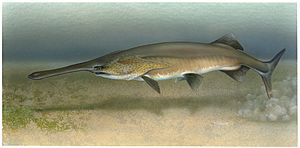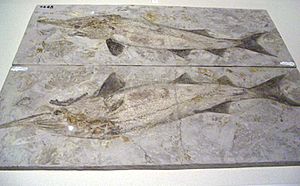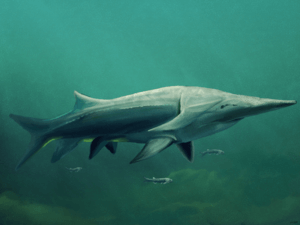Paddlefish facts for kids
Quick facts for kids Paddlefishes |
|
|---|---|
 |
|
| The American paddlefish, Polyodon spathula | |
 |
|
| The Chinese paddlefish, Psephurus gladius | |
| Scientific classification |
|
| Kingdom: | Animalia |
| Phylum: | Chordata |
| Class: | Actinopterygii |
| Order: | Acipenseriformes |
| Suborder: | Acipenseroidei |
| Family: | Polyodontidae Bonaparte, 1838 |
| Genera | |
|
Recent genera Fossil genera
|
|
Paddlefish (family Polyodontidae) are a special type of ray-finned fish. They are often called "primitive fish" because they haven't changed much in their looks for over 120 million years! That's a long time, back to the age of dinosaurs.
You can find them mostly in North America and China, both today and in their fossil records. There are six known species. Four of these are only known from fossils. The two species that lived more recently are the American paddlefish (Polyodon spathula) and the Chinese paddlefish (Psephurus gladius).
The American paddlefish lives in the Mississippi River basin in the U.S. Sadly, the Chinese paddlefish was last seen in 2003 in the Yangtze River in China and was likely extinct by 2019. People also called the Chinese paddlefish "Chinese swordfish" or "elephant fish."
Paddlefish numbers have dropped a lot. This is due to too much fishing, pollution, and human development. Building dams, for example, blocks their path to where they lay eggs. Changes to rivers also destroy their homes and places where young fish grow up.
Contents
What Paddlefish Look Like
When paddlefish are very young, they don't have their long snout, called a rostrum. It starts to grow soon after they hatch. The Chinese paddlefish had a narrow, sword-like snout. The American paddlefish has a wide, paddle-like snout.
Both types of paddlefish have a smooth, scaleless body shaped like a spindle. They have a tail where the top part is longer than the bottom, and small, not-so-good eyes.
How They Eat
The Chinese paddlefish was a carnivore, meaning it ate other fish. Its jaws pointed forward, suggesting it hunted small fish in the water. It also sometimes ate shrimp, bottom-dwelling fish, and crabs.
The American paddlefish eats differently. It is a filter feeder. This means it swims with its mouth open, filtering tiny animals called zooplankton from the water. It also sometimes eats small insects and their larvae.
Size of Paddlefish
The biggest Chinese paddlefish ever recorded was about 23 ft (7.0 m) long. It was thought to weigh thousands of pounds. They commonly grew to 9.8 ft (3.0 m) and 1,100 lb (500 kg).
The American paddlefish is one of the largest freshwater fish in North America. However, it is smaller than the Chinese paddlefish. American paddlefish often grow to 5 ft (1.5 m) or more and can weigh over 60 lb (27 kg).
The largest American paddlefish caught on record was in 1916 in Iowa. It was 7 ft 1 in (2.16 m) long and weighed over 198 lb (90 kg). More recently, in 2020, two even larger paddlefish were caught in Oklahoma. One weighed 146 lb (66 kg), and another weighed 151 lb (68 kg) and was almost 6 ft (1.8 m) long!

How They Sense Food
Scientists used to think paddlefish used their snouts to dig in the mud. But now we know they have special sensors on their snouts. These sensors can detect weak electrical fields. This helps them find prey, like the tiny zooplankton that American paddlefish eat. They can even sense the small movements of zooplankton's legs!
Paddlefish have poor eyesight, so they rely on these sensors to find food. These sensors are not just on their snout. They also have sensory pores covering almost half of their skin, from their snout to their head and gill flaps. This means that even if a paddlefish's snout is damaged, it can still find food and stay healthy.
Where Paddlefish Live
Over the last 50 years, paddlefish numbers have gone down. This is because of too much fishing, pollution, and human development. Dams, for example, block their path to places where they lay eggs. Changes to rivers also destroy their homes and places where young fish grow up.
American paddlefish have disappeared from many northern areas, including the Great Lakes and parts of Canada, New York, Maryland, and Pennsylvania. There is worry about their populations in other states too.
Chinese Paddlefish Habitat
The Chinese paddlefish lived in the Yangtze River in China. They mostly stayed in the main parts of the river and shallow areas near the East China Sea. They seemed to prefer the middle and lower parts of the water. They sometimes swam into large lakes. As mentioned, there have been no sightings of Chinese paddlefish since 2003.
American Paddlefish Habitat
American paddlefish live in the Mississippi River basin. This area stretches from New York to Montana and south to the Gulf of Mexico. They are found in medium to large rivers with long, deep, slow-moving pools. They also live in lakes and bayous.
Their historical range included parts of Canada, but they are now considered to have disappeared from there. The IUCN Red List says that Canadian paddlefish populations are gone, with no records since the early 1900s. The American paddlefish species is listed as "vulnerable," meaning it's at risk. Its international trade has been limited since 1992 under an agreement called CITES.
Life Cycle of Paddlefish
Paddlefish live a long time and mature late. Females don't start laying eggs until they are 7 to 10 years old. Some even wait until they are 16 to 18 years old. Males start laying sperm around age 7, or sometimes 9 or 10.
Paddlefish lay their eggs in late spring. This only happens if the conditions are just right. These conditions include the right water flow, temperature, amount of daylight, and gravel areas for spawning. If any of these are not met, they won't lay eggs that year. Research suggests females don't lay eggs every year. They usually do it every second or third year. Males lay sperm more often, usually every year or every other year.
Spawning Habits
Paddlefish swim upstream to lay their eggs. They like gravel bars that are usually exposed to air or covered by very shallow water. But during spring floods from melting snow and rain, these areas become covered by deeper water.
They are called "broadcast spawners." This means that the female releases her eggs into the water over bare rocks or gravel. At the same time, the male releases his sperm. The eggs are fertilized outside the body. The eggs are sticky and attach to the rocks. After hatching, the young fish are carried downstream and grow into adults in deep freshwater pools.
Raising Paddlefish
New methods in science have greatly improved how paddlefish are raised in captivity. This has led to more successful breeding and better survival rates for paddlefish grown for breeding or to help wild populations. These improvements have made it possible to raise paddlefish in reservoirs and ponds. This has also increased interest in raising paddlefish with other fish for food.
In the 1970s, the U.S. and the former Soviet Union worked together. American paddlefish were brought to the Soviet Union for aquaculture (fish farming). They started with 5,000 young fish from hatcheries in Missouri. These fish were introduced into several rivers in Europe and Asia. They became the first group of paddlefish successfully bred in Russia in the 1980s.
Now, paddlefish are being raised in countries like Germany, Austria, the Czech Republic, and Bulgaria. In 1988 and 1989, they were successfully bred there. Young paddlefish were then sent to Romania and Hungary. In 2006, paddlefish of different sizes were caught in the Danube River in Serbia.
In 1988, fertilized paddlefish eggs and young fish from Missouri were first brought to China. Since then, China imports about 4.5 million fertilized eggs and young fish every year from Russia and the United States. Some of these paddlefish are raised in carp ponds and sold to restaurants. Others are raised for breeding and for their eggs, which are used to make caviar. China has also sent paddlefish to Cuba for caviar farming.
Paddlefish Family Tree
There are two types of paddlefish that are alive or were alive recently. There are also three types that are only known from fossils.
Polyodontidae
- Subfamily †Paleopsephurinae
- Genus †Paleopsephurus MacAlpin, 1947
- Species †Paleopsephurus wilsoni MacAlpin, 1947
- Genus †Paleopsephurus MacAlpin, 1947
- Subfamily Polyodontinae
- Genus †Crossopholis Cope, 1883
- Species †Crossopholis magnicaudatus Cope, 1883
- Genus Polyodon Lacépède, 1797
- Polyodon spathula Walbaum, 1792 American paddlefish
- †Polyodon tuberculata Grande & Bemis, 1991
- Genus Psephurus Günther, 1873
- Psephurus gladius E. von Martens, 1862 Chinese paddlefish (likely extinct as of 2019, last seen in 2003)
- Genus †Crossopholis Cope, 1883
- Subfamily †Protopsephurinae Grande & Bemis, 1996
- Genus †Protopsephurus Lu, 1994
- Species †Protopsephurus liui Lu, 1994
- Genus †Protopsephurus Lu, 1994
See also
 In Spanish: Peces espátula para niños
In Spanish: Peces espátula para niños



